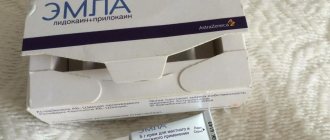Pharmacological properties of the drug Geviran
pharmacodynamics. Geviran is an antiviral drug. Active against herpes simplex virus (HSV-1 and HSV-2) , varicella zoster virus (VZV) and, to a lesser extent, Epstein-Barr virus (EBV) and cytomegalovirus (CMV) . Pharmacokinetics. Acyclovir is partially (15–30%) absorbed in the small intestine. Eating does not affect the absorption of the drug. The maximum concentration in blood plasma after taking the drug at a dose of 800 mg is 702.44 mcg/l and is achieved after 1.7 hours. Acyclovir is well distributed in the tissues and biological fluids of the body, in particular in the tissues of the brain, kidneys, lungs, liver, muscles , spleen, uterus, vaginal mucosa and in vaginal secretions, saliva, CSF, in the fluid of herpetic vesicles, as well as in sperm, reaching concentrations in it approximately 1.4 and 4 times higher than in blood plasma when taking the drug orally in doses of 400 mg and 1 g, respectively. The volume of distribution is 1.4 l/kg body weight. Approximately 9–33% of acyclovir is bound to plasma proteins. Acyclovir penetrates the placental barrier and the BBB. The drug is excreted in breast milk in a concentration higher than in the mother's blood plasma. Acyclovir is biotransformed mainly with the formation of 9-carboxymethoxymethylguanine, and to a lesser extent with the formation of 8-hydroxy-9-(2-hydroxyethoxymethyl)-guanine. in vitro studies in cells infected with herpes virus, acyclovir was also biotransformed to form acyclovir phosphate, diphosphate and triphosphate, mainly through intracellular phosphorylation involving thymidine kinase. Acyclovir is excreted in the urine by glomerular filtration and tubular secretion, 89–90% unchanged, 8–14% as the metabolite 9-carboxymethoxymethylguanine and 0.2% as 8-hydroxy-9-( 2-hydroxy-ethoxymethyl)-guanine within 72 hours. Less than 2% of the dose taken is excreted in the feces. In patients without signs of renal impairment, the half-life is 3–6 hours. In adults with renal insufficiency, the half-life may increase depending on the severity of renal insufficiency. In children over 1 year of age, the half-life of acyclovir approaches that of adults.
Reviews about Geviran
Diseases caused by the herpes simplex virus are the most common among viral infections. acyclovir is effective against these viruses .
There are many reviews about taking the drug for herpes zoster . Patients note that they took treatment for 10 days and the best effect was with early treatment: on the second day pain decreases, temperature decreases, new rashes do not appear and crusts quickly form on the elements of the rash. Patients also believe that this is an effective remedy for herpes simplex .
- “... Herpes tormented me every month, but I didn’t pay attention to it. Each time the rashes became more widespread and the last time they included the nose. On the doctor’s recommendation, I bought Geviran tablets, which I took for 10 days. I had already forgotten about my illness. Helped me."
- “... My husband walks around endlessly with herpes on his lips. I didn’t treat it thoroughly, only occasionally lubricating it with ointment. On the day of the dentist's appointment, the same problem appeared. The doctor did not take him for treatment and prescribed Geviran. It turns out that the treatment was started on the same day, so one small bubble did not increase in size and no new rashes appeared during the day. After three days it dried out and a crust appeared. We were surprised by the result."
Reviews contain information about side effects. Most often it is fatigue, headache , drowsiness .
Indications for use of the drug Geviran
For medicinal purposes:
- acute infections caused by the chickenpox virus and herpes zoster (Varicella Zoster) ;
- infections of the skin and mucous membranes caused by the herpes simplex virus , including damage to the reproductive system by the herpes simplex
For the purpose of prevention:
- infections caused by the herpes simplex virus (Herpes simplex) of the skin and mucous membranes in patients with immunodeficiency.
Geviran price, where to buy
It is currently impossible to buy Geviran. In the pharmacy chain you can buy Acyclovir, which is presented by imported and domestic manufacturers, so the cost varies. The cost of 20 tablets is 167-183 rubles. (Akrikhin, Russia) and 378-381 rub. (Belupo, Croatia).
- Online pharmacies in UkraineUkraine
Pharmacy24
- Geviran 800 mg No. 30 tablets Pharmaceutical plant "POLFARMA" S.A., Poland
732 UAH. order - Geviran 400 mg No. 30 tablets Pharmaceutical plant "POLFARMA" S.A., Poland
385 UAH. order
Use of the drug Geviran
Treatment should begin as early as possible when the first signs of infection appear. The drug is administered orally. Dosage for adults For acute infection caused by the varicella-zoster virus (Varicella-Zoster) Chickenpox 800 mg (4 tablets of 200 mg, or 2 tablets of 400 mg, or 1 tablet of 800 mg) 4 times a day for 5–7 days. Treatment should begin within the first 24 hours from the appearance of the rash. Herpes zoster 800 mg (4 tablets of 200 mg, or 2 tablets of 400 mg, or 1 tablet of 800 mg) 4 times a day for 7 days. Infection caused by the herpes simplex virus 200 mg 5 times a day with an interval of 4 hours between doses and a night break, usually for 5 days. In severe cases, the drug should be used for up to 10 days. In patients with reduced immunity, the dose can be increased to 400 mg per dose. Herpetic infection of the genital organs For primary infection, prescribe 200 mg (1 tablet 200 mg) every 4 hours (5 times a day) for 10 days. For the purpose of prevention in case of recurrence of infection, 400 mg (1 tablet of 400 mg or 2 tablets of 200 mg) is prescribed 2 times a day or 200 mg 3-4 times a day. Use for 6–12 months. The recurrence rate of untreated herpetic organ infections may vary over time. Treatment should be stopped every 6–12 months to assess the advisability of further drug therapy. Periodic treatment 200 mg every 4 hours (5 times a day) for 5 days after the first symptoms of recurrent infection appear. Dosage for renal failure:
Renal function without impairment, dosage | Creatinine clearance, ml/min | Kidney failure | |
Dose, mg | Interval between doses | ||
| 200 mg every 4 hours | 10 | 200 | Every 4 hours 5 times a day |
| 0–10 | 200 | Every 12 hours | |
| 400 mg every 12 hours | 10 | 400 | Every 12 hours |
| 0–10 | 200 | Every 12 hours | |
| 800 mg every 4 hours | 25 | 800 | Every 4 hours 4 times a day |
| 10–25 | 800 | Every 8 hours | |
| 0–10 | 800 | Every 12 hours | |
Dosing in elderly patients. In elderly patients, the total clearance of acyclovir decreases in parallel with creatinine clearance, so treatment with the drug must be started in low doses. Drink plenty of fluids while taking high doses of acyclovir. The drug should be used with particular caution in elderly patients with renal failure. Dosing in children Treatment and prevention of infections caused by the herpes simplex virus in children with immunodeficiency: children under 2 years of age are prescribed half the adult dose. For children over 2 years of age, dosage is the same as for adults. Infection caused by the varicella zoster virus Children under 2 years of age - 200 mg of acyclovir 4 times a day. Children aged 2–5 years - 400 mg of acyclovir 4 times a day. Children over 6 years old - 800 mg of acyclovir 4 times a day. Treatment must be continued for 5 days. Dosing should be based on 20 mg/kg body weight per dose (but not more than 800 mg of acyclovir) 4 times a day. Children weighing more than 40 kg - dosage as in adults with chickenpox. There are no data regarding the treatment of herpes zoster infection in immunocompromised children.
Analogs
Level 4 ATC code matches:
Herperax
Vivorax
Vairova
Acyclostad
Walcyte
Valavir
Ribavirin
Valtrex
Valvir
Rebetol
Cyclovir
Famciclovir Teva
Famvir
Valaciclovir
Acyclovir , Herpevir , Virolex , Herpeblok , Zovirax .
Special instructions for the use of the drug Geviran
The drug should be used with caution in patients with renal failure, especially with dehydration, after a course of treatment with high doses of acyclovir, as well as in cases of concomitant use of potentially nephrotoxic drugs. The patient should be informed that if symptoms of a genital herpes infection appear, it is necessary to abstain from sexual intercourse. During treatment, you should drink enough fluids. Use during pregnancy and lactation There are no data from controlled studies regarding the use of acyclovir in pregnant women, therefore the drug can be used during pregnancy only if the expected benefit to the expectant mother outweighs the potential risk to the fetus. Acyclovir passes into breast milk. Given the possibility of side effects in an infant, you should not take the drug during breastfeeding or you should stop breastfeeding. Impact on the ability to drive vehicles or operate complex machinery. During treatment, due to the likelihood of side effects, taking acyclovir may affect driving and servicing machinery.
Side effects
Common adverse reactions:
- nausea, abdominal pain, diarrhea ;
- itching, rash;
- temperature increase;
- dizziness , headache ;
- increased sensitivity to light;
- fatigue.
Rarely encountered adverse reactions:
- anemia , leukopenia , thrombocytopenia ;
- anaphylactic reactions;
- agitation, tremor , hallucinations , dysarthria , convulsions , drowsiness , coma ;
- suffocation;
- increased bilirubin and liver transaminases ;
- hepatitis , jaundice ;
- hives;
- vasomotor edema;
- alopecia.
Pharmacological properties
Pharmacological
Geviran is an antiviral drug.
Active against herpes simplex (HSV-1 and HSV-2), chickenpox and herpes zoster (VZV) and to a lesser extent against Epstein-Barr virus (EBV) and cytomegalovirus (CMV). During cytomegalovirus infection, phosphorylation of acyclovir is partially carried out using a specific enzyme. Pharmacokinetics
Suction.
Acyclovir is partially (15-30%) absorbed in the small intestine. Food intake does not affect the absorption of the drug. The maximum Cmax concentration after taking the drug at a dose of 800 mg is 702.44 mcg/l after tmax 1.7 hours.
Distribution
Acyclovir is well distributed in tissues and body fluids, in the brain, kidneys, saliva, lungs, liver, muscles, spleen, uterus, vaginal mucosa and vaginal secretions, cerebrospinal fluid and herpetic vesicle fluid, as well as in semen, reaching a concentration of approximately 1.4 and 4 times higher than in plasma when taken orally in doses of 400 mg and 1 g
The volume of distribution is 1.4 l/kg. 9-33% of acyclovir is bound to plasma proteins.
The drug penetrates the placental barrier. Some data indicate that the drug is excreted into breast milk in greater concentrations than the concentration in maternal plasma.
Metabolism
Acyclovir is biotransformed mainly to form 9-carboxymethoxymethylguanine, and to a lesser extent to 8-hydroxy-9-(2-hydroxyethoxymethylguanine)-guanine.
In in vitro studies on cells infected with the herpes virus, acyclovir is also biotransformed to form acyclovir phosphate, diphosphate and triphosphate, mainly through intracellular phosphorylation with the participation of thymidine kinase.
Conclusion
Acyclovir is excreted mainly in the urine by glomerular filtration and tubular secretion in 89-90% unchanged, 8-14% in the form of the metabolite 9-carboxymethoxymethylguanine, less than 0.2% in the form of 8-hydroxy-9-(2 -hydroxy-ethoxymethyl)-guanine within 72 hours, less than 2% of the dose is excreted in the feces.
In patients with normal renal function, the half-life (t0.5) after taking the drug averages 3-6 hours
In adults with renal failure, t0.5 may be prolonged depending on the degree of renal failure.
In children over 1 year of age, the half-life of acyclovir approaches the half-life of adults.
INDICATIONS
For medicinal purposes:
· Acute infections caused by the chickenpox virus and herpes zoster (Varicella Zoster);
· Infections caused by the herpes simplex virus (Herpes simplex) of the skin and mucous membranes; including damage to the reproductive system by herpes simplex (primary and recurrent genital herpes).
For the purpose of prevention
infections caused by the herpes simplex virus (Herpes simplex) of the skin and mucous membranes in patients with immunodeficiency.
APPLICATION Geviran tablet
800 mg. No. 30.
Treatment should begin as quickly as possible, immediately after the first symptoms of infections appear.
The drug is administered orally.
Dosage in adults.
For acute infection caused by the varicella zoster virus (Varicella Zoster).
Chicken pox.
800 mg (4 tablets of 200 mg, or 2 tablets of 400 mg or 1 tablet of 800 mg) 4 times a day for 5-7 days. Treatment should begin in the first 24 hours from the moment the rash appears.
Shingles.
800 mg (4 tablets of 200 mg, or 2 tablets of 400 mg or 1 tablet of 800 mg) 4 times a day for 7 days.
Infection caused by the herpes simplex virus.
200 mg 5 times a day with an interval of 4 hours between doses and a night break, usually for 5 days. In severe cases of infectious disease, the drug should be used for up to 10 days. In patients with reduced immunity, the dose can be increased to 400 mg per dose.
Herpetic infection of the genital organs.
· For primary infection, prescribe 200 mg (1 tablet of 200 mg) every 4 hours (5 times a day) for 10 days.
· For the purpose of prevention in cases of recurrent infection, 400 mg (1 tablet of 400 mg or 2 tablets of 200 mg) is prescribed 2 times a day or 200 mg 3-4 times a day. Use for 6-12 months.
The rate of recurrence of untreated herpes infections may vary over time. Treatment must be stopped every 6-12 months in order to assess the advisability of further drug therapy.
Periodic treatment
200 mg every 4 hours (5 times a day) for 5 days after the first symptoms of recurrent infection appear.
Kidney failure
Dosing in patients with normal renal function
200 mg every 4 hours
400 mg every 12 hours
800 mg every 4 hours
Dosing in elderly patients
In elderly patients, the total clearance of acyclovir decreases in parallel with creatinine clearance, so treatment should be started with low doses of the drug. When taking large doses of acyclovir, you should drink plenty of fluids.
The drug should be used with particular caution in elderly patients with renal failure.
Dosage in children
Treatment and prevention of infections caused by the herpes simplex virus in children with immunodeficiency:
Children under 2 years of age - use half the dose for adults.
Children over 2 years old - dosage as for adults.
Infection caused by the varicella zoster virus.
Children under 2 years old - 200 mg of acyclovir 4 times a day.
Children from 2 years to 5 years - 400 mg of acyclovir 4 times a day.
Children over 6 years old - 800 mg of acyclovir 4 times a day.
Treatment must be continued for 5 days. The dosage should be accurately calculated, on average, at the rate of 20 mg / kg per dose (but not more than 800 mg of acyclovir) 4 times a day.
Children weighing more than 40 kg - dosage as in adults with chickenpox.
There are no data regarding the treatment of herpes zoster infection in immunocompromised children.
Side effect
Nausea, vomiting, diarrhea, abdominal pain, headache, rarely - dizziness, hallucinations, drowsiness, confusion, blurred vision, itching, rash, slight increase in bilirubin levels and aminotransferase activity, slight increase in urea and creatinine levels in the blood, slight decrease hematological parameters, increased fatigue.
Contraindications
Hypersensitivity to acyclovir and other components of the drug.
Overdose
In case of overdose, gastrointestinal disorders (nausea, vomiting), neurological disorders (headache, dizziness, convulsions) are observed. Treatment is symptomatic. Acyclovir can be removed from the body by hemodialysis.
Features of application
· The drug should be used with caution in patients with renal failure, especially in dehydrated patients, those who have been treated with high doses of acyclovir, or in patients concomitantly taking other drugs that may damage the kidneys.
· The patient should be informed that if symptoms of a genital herpes infection appear, one should refrain from sexual intercourse.
· During treatment, you must drink enough fluid.
Pregnancy and lactation period.
There are no controlled studies on the use of acyclovir in pregnant women. Therefore, during pregnancy the drug is used only when the expected benefit to the mother outweighs the potential risk to the fetus.
Acyclovir passes into breast milk, so you should not take the drug while breastfeeding. If necessary, use of the drug during lactation should be discontinued.
Effect on the ability to drive a car or work with Geviran table. 800 mg. No. 30 by mechanisms.
During treatment, due to side effects, acyclovir may affect driving and operating machinery.
Interaction with other drugs
Drugs that affect renal function may alter the pharmacokinetics of acyclovir. Probenecid and cimetidine increase the area of the plasma concentration curve of acyclovir and reduce the renal clearance of acyclovir.
Storage conditions
Store in a dry place, protected from light, at temperatures up to 25 º C.
Shelf life: 3 years.
Attention! The description of the drug on this page is simplified. Before purchasing and using the drug, consult your doctor or pharmacist, and also read the instructions approved by the manufacturer. Information about the drug is provided for informational purposes only and should not be used as a guide to self-medication. ATTENTION! This section is provided for informational purposes only and is not a catalog or price list of our company. To obtain information about the availability of drugs, call + 99871 202 0999 Pharmacy Network Helpline 999.


